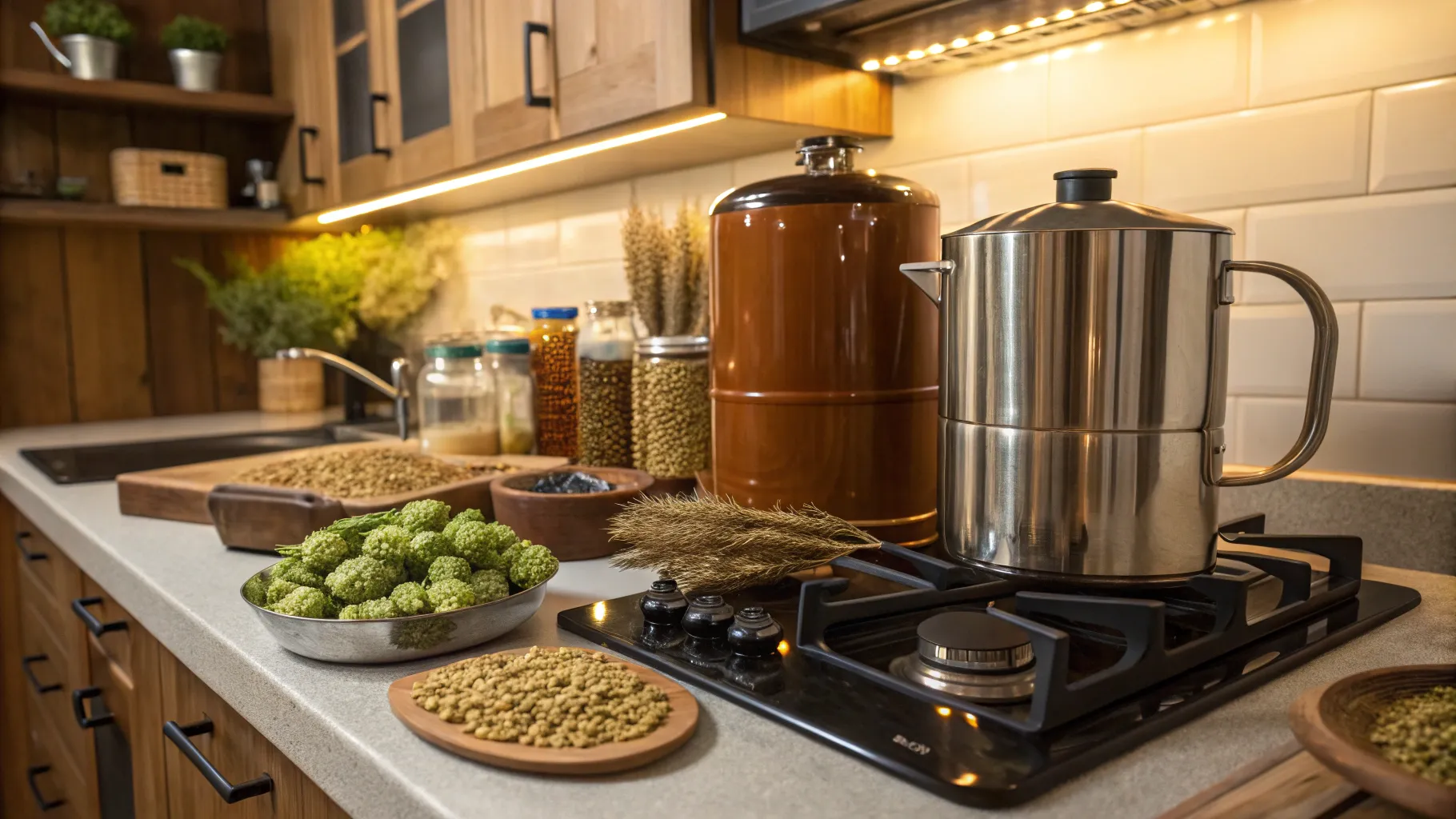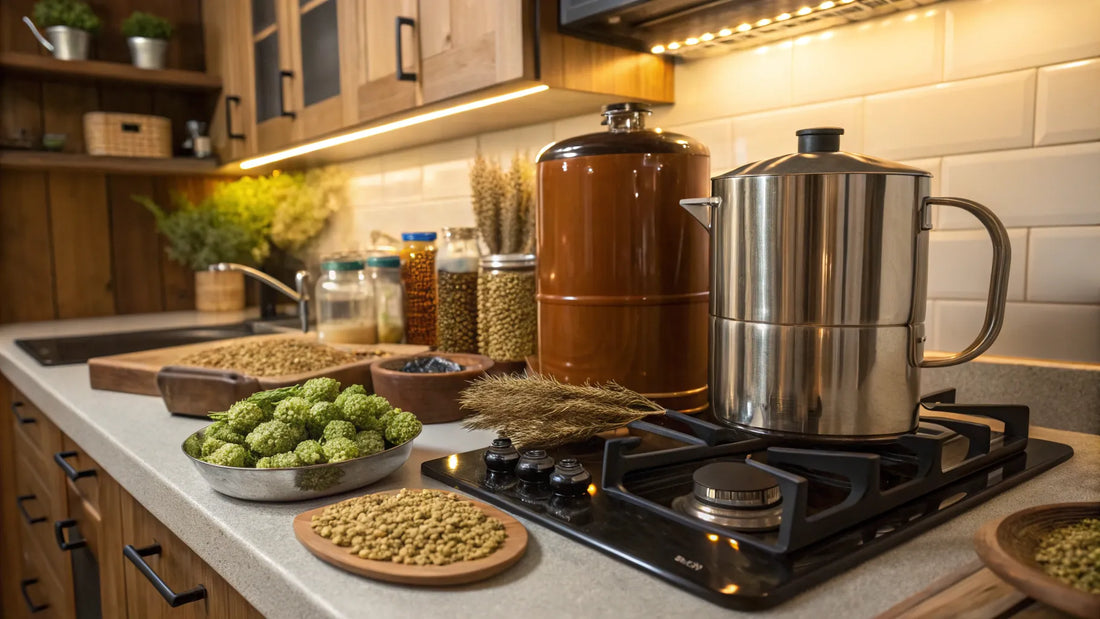Five tips for boiling in homebrewing (from a pro!)

Welcome to our second episode of the homebrewing series, where we explore the art of boiling beer together with Andy Parker from Elusive Brew. This time we dive into the details of boiling, from techniques to ingredients and the incredible variety of hop types.
Introducing Mont Miller 🍻
Mont Miller is a true treasure trove for homebrewers. Located in Swindon, UK, this place offers a wide range of equipment and ingredients that will inspire every brewer. It almost feels like a Willy Wonka factory for beer lovers. From unique yeast strains to innovative brewing kits, Mont Miller has everything you need to take your brewing experience to the next level.
Their team is not only knowledgeable but also passionate about brewing. They are always willing to share their knowledge and help you choose the right products for your brewing projects. Whether you are a beginner or a seasoned professional, Mont Miller has something for everyone.
What is the boiling phase? 🍲
The boiling phase is a crucial part of the brewing process. It is the moment when the wort is heated to the boiling point, deactivating enzymes and concentrating the sugars. This process is not only essential for the taste but also for the stability of the beer.
During the boiling, hops and other ingredients are added, leading to the development of aromas and flavors. It is also the phase where you can adjust the bitterness of the beer by adding the right hop varieties at the right time.
The boiling phase offers brewers the opportunity to be creative and experiment with different ingredients, which can lead to unique and interesting beer recipes.
What is first wort hopping? 🌿
First wort hopping is a technique where hops are added to the wort before it is brought to a boil. This allows for a longer extraction time of the alpha acids, leading to a softer bitterness in the final product. The idea is that by adding the hops earlier, you get a more balanced and complex flavor.
Another advantage of first wort hopping is that it can help prevent boil-overs. The hops help break the surface tension of the wort, reducing the risk of boil-overs during boiling. This makes it a smart technique for both homebrewers and commercial breweries.
Although there is much debate about the effectiveness of this technique, many brewers have experienced positive results by incorporating first wort hopping into their brewing process.
Advantages of extracts 💧
Extracts are a convenient way to control the bitterness and flavor of your beer. They are highly concentrated and require less plant material during the boiling phase, reducing the risk of unwanted vegetal flavors. This makes them ideal for brewers seeking precision in their recipes.
Another great advantage of using extracts is the efficiency in storage and use. They are easier to measure and add, which speeds up the brewing process. This is especially useful for commercial breweries producing large quantities of beer.
Extracts can also help create a cleaner bitterness, which means you have more control over the final taste of your beer. This is crucial for achieving specific beer recipes and flavors.
Different types of hops 🌸
Hops are one of the main ingredients in beer and come in various types and forms. Each hop variety has unique properties that influence the taste, aroma, and bitterness of the beer. Understanding these differences can help you brew better.
- Bittering hop: These hop varieties are mainly used to add bitterness to the beer. They are often added early in the boiling process.
- Aroma hop: These hop varieties are added later to enhance the aromas. They are usually less bitter and bring fruity or floral notes to the beer.
- Extract hop: These are concentrated hop forms used for precision in bitterness and aroma. They are convenient for commercial breweries.
- Whole cone hop: This hop form retains more of the natural oils and flavors, which can lead to a richer taste.
- Pellet hop: These are compressed hop cones that take up less volume and are easier to handle than whole cone hops.
When choosing hops, it is important to consider the type of beer you are making and the flavors you want to achieve. Experiment with different hop varieties to create unique beer recipes that suit your taste.
What are BBC and HBC hops? 🌱
BBC hops, or Boston Beer Corporation hops, are a type of hop known for their high concentration and softer flavors. These hops are ideal for homebrewers looking for a consistent and refined taste in their beers. They are particularly useful in dry hopping because they dissolve faster in the beer, providing optimal flavor release.
HBC hops, or hops from the Hop Breeding Company, are often experimental or prototype hops. These hops are still being developed and tested, which means they can offer unique flavors and aromas not yet on the market. Using HBC hops can enrich your brewing experience and give you the chance to create something new and exciting.
T90 versus T45 hop pellets ⚖️
T90 and T45 are two different types of hop pellets specially designed for brewing purposes. T90 pellets contain about 10% less plant material than traditional hops, resulting in a more concentrated and efficient extraction of flavors and aromas. This makes them popular among brewers who want a powerful bitterness without unwanted plant flavors.
T45 pellets, on the other hand, contain up to 55% less plant material. This means they are even more concentrated than T90 pellets. This gives you an even more intense flavor and aromas from the hops, making them ideal for creating unique beer recipes. Choosing between T90 and T45 depends on the specific needs of your recipe and the desired flavor profiles.
Newest hop products: Flex, Incognito, and Spectrum 🚀
The brewing world is constantly evolving, and new hop products like Flex, Incognito, and Spectrum offer exciting possibilities for homebrewers. Flex is a super-concentrated bitter extract ideal for achieving the desired bitterness without adding an abundance of plant material.
Incognito is a liquid hop product mainly used during whirlpooling. It offers powerful aroma extraction, allowing you to add more scent and flavor to your beer without extra bitterness. This product is perfect for creating hoppy beers with an intense aroma.
Spectrum is a soluble product that can be added as part of your dry hopping. It is designed to release a wide range of aromas and oils from the hops, providing a rich and complex flavor experience. These new products give brewers the flexibility to further refine and innovate their beer recipes.
Pellets versus whole hops 🌾
A common discussion among brewers is the choice between pellets and whole hops. Pellets offer several advantages, such as better storage capacity and efficiency during the brewing process. They are easier to measure and add, making the brewing process faster and simpler.
Whole hops, on the other hand, retain more of the natural oils and flavors. This can lead to a richer and more complex taste in the final product. Many brewers believe that whole hops give a more "authentic" feel of the hop because they are less processed. The choice between pellets and whole hops depends on your equipment and the specific characteristics of the beer you want to brew.
Adding non-hoppy ingredients 🍊
When brewing beer, adding non-hoppy ingredients is a great way to create unique flavors. Think of herbs, spices, and even fruit. These ingredients can add a delightful aroma and flavor profile to your beer, making it a special experience for the drinker.
For example, adding orange peel or coriander can give your beer a refreshing touch. Some brewers even experiment with unusual additions, such as fenugreek, which can mimic a flavor reminiscent of maple syrup. This kind of creativity can lead to surprising and tasty results.
It is important to add these non-hoppy ingredients at the end of the boiling process, as otherwise they can add bitterness that you might not want. By adding them at the right time, you can extract the maximum flavor and aroma from these ingredients without disturbing the balance of your beer.
Unusual additions to cooking 🍊
When brewing beer, there are many classic ingredients, but adding unusual elements can lead to surprising and exciting flavors. Think of herbs, spices, and even fruit. These additions can create a unique aroma and flavor profile that sets your beer apart from the rest.
Take fenugreek, for example, which can mimic a delicious maple syrup-like flavor. This ingredient does not ferment completely, allowing you to retain the rich, sweet notes that you might otherwise lose when using real maple syrup. It's a great way to integrate that unique flavor without the downsides of fermentation.
In addition, ingredients such as orange peel and coriander can give your beer a fresh, aromatic touch. It is important to add these additions at the end of the boiling process to preserve the maximum flavor without creating unwanted bitterness.
Examples of unusual additions
- Cacao nibs: For a chocolatey note in your stout.
- Pepper: For a light kick in your beer, ideal for wits and saisons.
- Ginger: For a spicy, refreshing taste.
- Lavender: For a floral, aromatic experience.
- Coffee: For a rich, roasted flavor in your stout or porter.
Experimenting with these unusual ingredients can lead to unique beer recipes that will surprise your friends and family. Dare to be creative and try different combinations to create your own signature beer!
The golden rule of hopping ⚖️
One of the most important lessons every brewer must learn is the golden rule of hopping: you can always add more, but you can't take it back. This is especially true for using herbs and spices. Too much of something can quickly ruin your beer, so be careful with the amounts you add.
For example, if you add a too strong spice, it can disrupt the entire balance of your beer. It's always better to start with a small amount and then add more if needed. This also applies to dry hopping; you can always add a second round, but removing excess hops is not an option.
It's a matter of finesse and precision. Keeping this rule in mind ensures your beers are well balanced and the flavors come through beautifully.
Boiling as a culinary opportunity 🍳
Boiling is not just a technical skill; it's also a chance to be creative. Think of the brewing process as a culinary experience. Just as a chef selects their ingredients and adjusts cooking time, you can also experiment with different hop varieties and additions.
Try different boiling times for your hops. Add hops at different moments to see how the flavors change. This can lead to a more complex and interesting final product. Additionally, you can vary the boiling temperatures to influence the extraction of flavors and aromas.
Remember that the boiling phase is a chance to refine your brewing skills. It's an opportunity to play with flavors and develop your own unique recipes. Let your creativity run free and try new techniques and ingredients to enrich your brewing experience.
Conclusion and reference to previous brewing videos 🎥
We hope these tips inspire you to take your brewing process to the next level. Boiling is a crucial part of the brewing process and offers countless opportunities to experiment and innovate. Remember that every brewer has their own style and preferences, so don't be discouraged to experiment!





